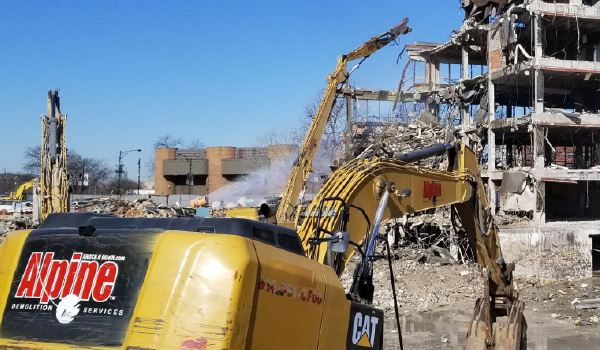From Concept to Completion: The Refine of Interior Demolition Explained
Wiki Article
The Ultimate Guide to Interior Demolition Techniques and Equipments
Within the realm of interior renovations, the art of demolition is a pivotal phase that calls for accuracy, ability, and the right set of tools. Whether you are a skilled expert or a DIY lover, understanding the intricacies of interior demolition techniques can make all the distinction in achieving a successful job outcome.Vital Interior Demolition Devices
When carrying out interior demolition jobs, having the appropriate devices is important for performance and safety. One of the most crucial devices for indoor demolition is the demolition hammer. This sturdy device is created to break with hard products like concrete, floor tile, and drywall.An additional vital device is a reciprocating saw, which is excellent for reducing through a variety of materials such as timber, steel, and plastic. Its capacity to make precise cuts in limited rooms makes it optimal for demolition job. An utility knife is necessary for cutting materials like rug, plastic floor covering, and insulation. Its sharp blade makes sure precise and clean cuts, assisting in the elimination of undesirable materials. Overall, having these important interior demolition tools will considerably enhance the efficiency and safety of any type of demolition task.

Safety Preventative Measures Throughout Demolition

Additionally, all workers associated with the demolition procedure need to get appropriate training on the appropriate handling of tools and tools to lessen crashes. It is important to protect the work area by erecting obstacles and indications to protect against unapproved gain access to - interior demolition. Routinely examining and preserving tools and devices can also add to a more secure working atmosphere. By adhering to these security preventative measures, interior demolition projects can be executed efficiently while focusing on the wellness of all individuals entailed.
Techniques for Eliminating Walls
Implementing correct safety preventative measures during indoor demolition tasks is critical for producing a safe and secure workplace, and one key element of such tasks entails understanding techniques for eliminating walls. One frequently made use of method is hand-operated demolition, which requires using standard hand tools such as sledgehammers, crowbars, and utility blades to carefully take apart the wall surface item by item. This technique enables for better control over the demolition process, especially in fragile locations where precision is important.For bigger, more complex walls, mechanical demolition might be essential. This involves using heavy machinery like excavators or bulldozers to tear down wall surfaces successfully. It is important to make sure that the architectural honesty of the structure is not endangered during mechanical demolition.
Another strategy for getting rid of walls is deconstruction, where the wall is dismantled in such a way that preserves recyclable materials. This sustainable technique is eco friendly and can likewise help in reducing disposal prices. Whichever method is used, it is important to comply with appropriate safety procedures and think about the structural implications of wall surface elimination to make sure a successful interior demolition project.
Removing Flooring Like a Pro
Efficiently getting rid of floor covering during indoor demolition calls for the proper tools and strategies to make certain a successful and smooth procedure. The very first step in removing floor covering is to remove the area of any kind of furniture or barriers. Next off, identify the kind of flooring to determine the appropriate elimination technique. For hardwood or laminate floor covering, start by getting rid of the baseboards and then make use of a flooring scraper to lift and detach the slabs. Rug elimination includes cutting the rug into convenient sections and rolling it up for disposal. For floor tile or vinyl floor covering, a sculpt or flooring scraper can be made use of to pry up the sheets or floor tiles. It's necessary to use safety gear such as handwear covers, goggles, and a mask to stop injuries and exposure to dirt and debris. In addition, having a dumpster or marked disposal area all set for the eliminated floor covering materials is critical for preserving a tidy work atmosphere. By adhering to these techniques and making use of the right devices, eliminating floor covering like a pro can be achieved effectively and effectively.Correct Garbage Disposal Approaches
After efficiently removing floor covering using the proper tools and techniques, the next essential action in the indoor demolition procedure is applying correct garbage disposal techniques. Appropriate waste disposal is essential for maintaining a tidy and secure workplace throughout and after demolition. Among the main methods for waste disposal is setting apart products into different groups such as recyclable, harmful, and basic waste. This segregation ensures that products are disposed of appropriately and properly.

Contractors should comply with regional laws regarding waste disposal to stay clear of penalties and penalties. Utilizing professional waste administration services can improve the disposal process and make sure conformity with ecological standards. By executing correct garbage disposal approaches, interior demolition projects can be completed efficiently and sustainably.
Final Thought
In verdict, indoor demolition calls for the use of essential tools and strict security precautions to ensure a effective and risk-free procedure. By following these standards, interior Click This Link demolition can be finished effectively and with marginal risks.
One of the most critical tools for indoor demolition is the demolition hammer (interior demolition). Overall, having these crucial interior demolition devices will substantially enhance the effectiveness and safety and security of any type of demolition task
Effectively removing flooring throughout interior demolition calls for the proper tools and strategies to Find Out More guarantee a successful and smooth procedure.After efficiently eliminating floor covering using the proper devices and techniques, the next critical step in the interior demolition process is carrying out proper waste disposal techniques.In verdict, indoor demolition requires the usage of important tools and rigorous safety and security precautions to make certain a risk-free and successful procedure.
Report this wiki page